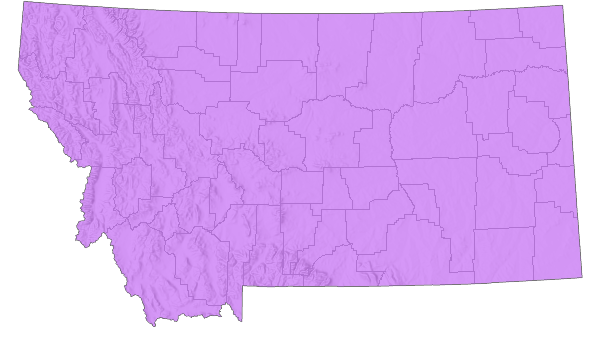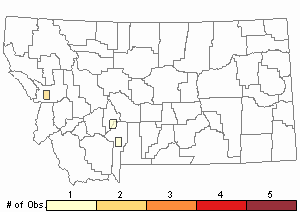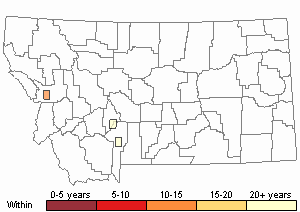View in other NatureServe Network Field Guides
NatureServe
Montana
Utah
Wyoming
Idaho
Wisconsin
British Columbia
South Carolina
Yukon
California
New York
Fusiform Camel Cricket - Ceuthophilus fusiformis
General Description
The following comes from Hebard (1928), Helfer (1971), Capinera and Sechrist (1982), Vickery and Kevan (1985), Capinera et al. 2004, and Scott (2010). Ceuthopilus and related genera all have several morphological and life history features in common. Their bodies are thick and dorsally arched, hence the name “camel”, and range in body length from 13 mm to 33 mm. Heads are large, oval, bent downward and backward between the front legs and bear long antennae. Their eyes are somewhat pear-shaped with the narrow end pointing ventrally. Front and middle femora are slender and short; hind femora are thick, slightly bowed inward to the body, usually spined ventrally in males, feebly so in females. All tarsi are 4 segmented. Female ovipositors are nearly straight, stout at the basal end, tapering to the middle and upturned apically. Both males and females possess two cerci (appendages attached to the posterior tip of the abdomen) which are lush with sensory receptors. Females have an ovipositor between the two sensory cerci. All Camel Crickets are wingless and do not sing or chirp. Body colors are variable among species with individuals from brown to straw-colored, to patterned with blackish markings.
Phenology
This species overwinters in the egg or nymph stage. However, adults have been found during every month of the year in the wild except January and February. Eggs hatch in April, but nymphal instars in various stages have been collected from April to October (Vickery and Kevan 1985).
Diagnostic Characteristics
The following comes from Hebard (1928), Helfer (1971), Capinera and Sechrist (1982), Vickery and Kevan (1985), Capinera et al. (2004), and Scott (2010). The body length is small and robust. The body color can vary from brownish to straw-colored, often patterned with black markings. The pronotal length in males is 2.9 mm to 3.9 mm, and for females 3.0 mm to 3.9 mm. Legs are short, stout, and pale in color. Male subgenital plate, at the tip of the abdomens’ genitalia, is small, and broadest at base with two triangular lobes separated by a deep cleft between the lobes. The female ovipositor is short and stout at the base, tapering at the basal half to a slender curved tip bearing ventral teeth at the tip which are slender and curved.
There are about 150 species of Camel Crickets in North America classified into 21 genera. Eighty-nine (59%) of those species are in the genus Ceuthophilus. The Alpine Camel Cricket can be easily confused with other species in the family, Rhaphidophoridae. However, only 5 species are presently known to occur in Montana, making identification somewhat simpler (Capinera et al. 2004).
Species Range
Montana Range
Range Descriptions

 Native
Native
Range Comments
The Fusiform Camel Cricket is a prairie and plains species, distributed across the Great Plains east of the Rocky Mountain Front from Alberta to Manitoba and southward to New Mexico and Oklahoma. In Montana it has been reported for 7 counties (Vickery and Kevan 1985, and Scott 2010).
Observations in Montana Natural Heritage Program Database
Number of Observations: 5
(Click on the following maps and charts to see full sized version)
Map Help and Descriptions
Relative Density

Recency


 (Observations spanning multiple months or years are excluded from time charts)
(Observations spanning multiple months or years are excluded from time charts)
Habitat
This species is common in grasslands and in the mountains above timberline up to 10,300 feet. It occurs on the ground, often under rocks, logs, in the nests of burrowing rodents, and among sedges in swampy-marsh areas. Occasionally it has been found in open areas of coniferous forests on mountain slopes. This species can also be found in and around human habitations, such as damp basements, utility rooms, firewood stacks, wells, and even move through plumbing to emerge in sink drains (Vickery and Kevan 1985).
Food Habits
The food habits of this species are poorly known but they seem to feed on dead and dying invertebrates and some plant materials (kinds undocumented), and have been reported to practice cannibalism under certain circumstances. Some species dwelling in houses (like this one) consume fabrics like curtains and clothing. A few homeowners have reported Camel Crickets even eating clothing hung outside to dry (Vickery and Kevan 1985).
Reproductive Characteristics
Unknown.
Stewardship Responsibility
References
- Literature Cited AboveLegend:
 View Online Publication
View Online Publication Capinera, J.L. and T.S. Sechrist. 1982. Grasshoppers of Colorado: Identification, Biology, and Management. Fort Collins, CO: Colorado State University Experiment Station, Bulletin 584S. 161 p.
Capinera, J.L. and T.S. Sechrist. 1982. Grasshoppers of Colorado: Identification, Biology, and Management. Fort Collins, CO: Colorado State University Experiment Station, Bulletin 584S. 161 p. Capinera, J.L., R.D. Scott, and T.J. Walker. 2004. Field Guide to Grasshoppers, Katydids, and Crickets of the United States. Ithaca, NY. Cornell University Press.
Capinera, J.L., R.D. Scott, and T.J. Walker. 2004. Field Guide to Grasshoppers, Katydids, and Crickets of the United States. Ithaca, NY. Cornell University Press. Hebard, M. 1928. The Orthoptera of Montana. Proceedings of the Academy of Natural Sciences of Philadelphia, Vol. 80:211-306.
Hebard, M. 1928. The Orthoptera of Montana. Proceedings of the Academy of Natural Sciences of Philadelphia, Vol. 80:211-306. Helfer, J.R. 1971. How to Know the Grasshoppers, Crickets, Cockroaches, and Their Allies. Revised edition (out of print), Mineola, NY: Dover Publications.
Helfer, J.R. 1971. How to Know the Grasshoppers, Crickets, Cockroaches, and Their Allies. Revised edition (out of print), Mineola, NY: Dover Publications. Scott, R.D. 2010. Montana Grasshoppers, Katydids, and Crickets A Pictorial Field Guide to the Orthoptera. MagpieMTGraphics, Billings, MT.
Scott, R.D. 2010. Montana Grasshoppers, Katydids, and Crickets A Pictorial Field Guide to the Orthoptera. MagpieMTGraphics, Billings, MT. Vickery, V. R. and D. K. M. Kevan. 1985. The grasshopper, crickets, and related insects of Canada and adjacent regions. Biosystematics Research Institute, Ottawa, Ontario. Publication Number 1777. 918 pp.
Vickery, V. R. and D. K. M. Kevan. 1985. The grasshopper, crickets, and related insects of Canada and adjacent regions. Biosystematics Research Institute, Ottawa, Ontario. Publication Number 1777. 918 pp.
- Additional ReferencesLegend:
 View Online Publication
View Online Publication
Do you know of a citation we're missing? Bland, R.G. 2003. The Orthoptera of Michigan—Biology, Keys, and Descriptions of Grasshoppers, Katydids, and Crickets. East Lansing, MI: Michigan State University Extension, Bulletin E-2815. 221 p.
Bland, R.G. 2003. The Orthoptera of Michigan—Biology, Keys, and Descriptions of Grasshoppers, Katydids, and Crickets. East Lansing, MI: Michigan State University Extension, Bulletin E-2815. 221 p.
- Web Search Engines for Articles on "Fusiform Camel Cricket"
- Additional Sources of Information Related to "Insects"





